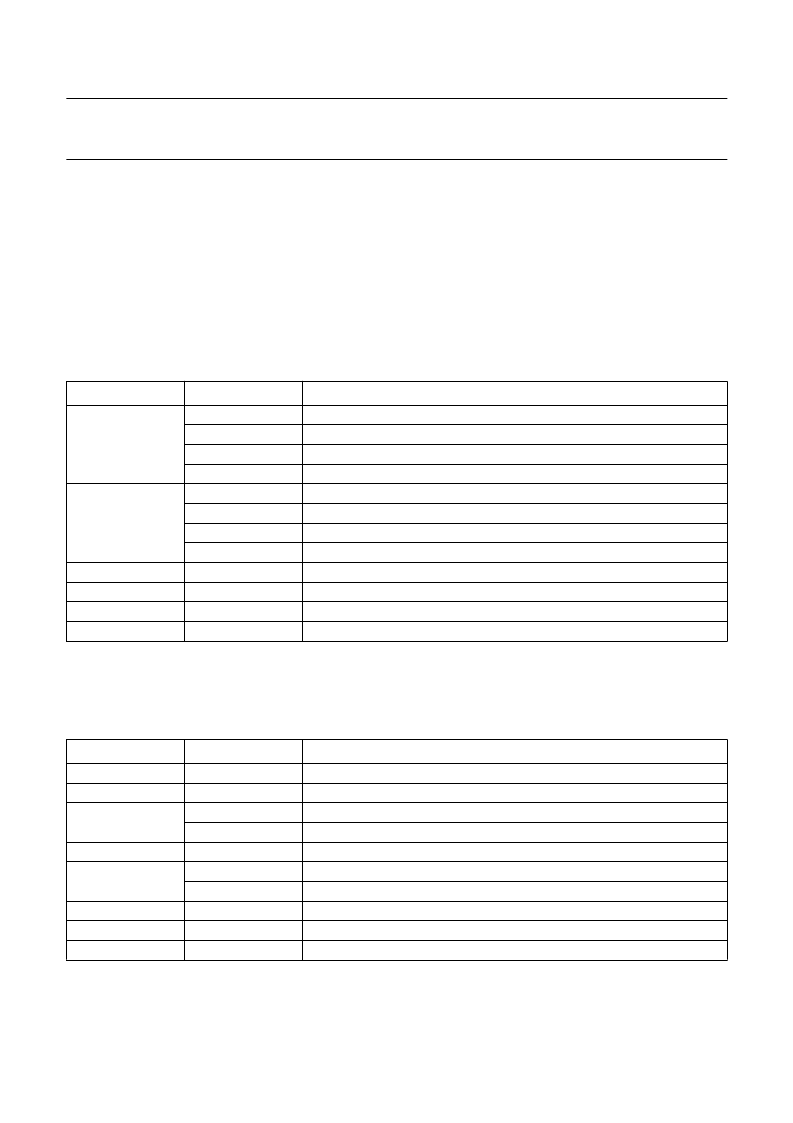- 您現(xiàn)在的位置:買賣IC網(wǎng) > PDF目錄382380 > PCD5003A (NXP Semiconductors N.V.) Enhanced Pager Decoder for POCSAG PDF資料下載
參數(shù)資料
| 型號: | PCD5003A |
| 廠商: | NXP Semiconductors N.V. |
| 英文描述: | Enhanced Pager Decoder for POCSAG |
| 中文描述: | 增強(qiáng)傳呼機(jī)POCSAG碼解碼器 |
| 文件頁數(shù): | 19/44頁 |
| 文件大小: | 233K |
| 代理商: | PCD5003A |
第1頁第2頁第3頁第4頁第5頁第6頁第7頁第8頁第9頁第10頁第11頁第12頁第13頁第14頁第15頁第16頁第17頁第18頁當(dāng)前第19頁第20頁第21頁第22頁第23頁第24頁第25頁第26頁第27頁第28頁第29頁第30頁第31頁第32頁第33頁第34頁第35頁第36頁第37頁第38頁第39頁第40頁第41頁第42頁第43頁第44頁

1999 Jan 08
19
Philips Semiconductors
Product specification
Enhanced Pager Decoder for POCSAG
PCD5003A
7.28
Status/control register
The status/control register consists of two independent
registers, one for reading (status) and one for writing
(control).
The status register shows the current operating condition
of the decoder and the cause(s) of an external interrupt.
The control register activates/deactivates certain
functions. Tables 14 and 15 show the bit allocations of
both registers.
All status bits will be reset after a status read operation
except for the out-of-range, battery-low and receiver
enable indicator bits (see note 1 to Table 14).
Status bit D0 is set when call reception is started by
detection of an enabled RIC (user address). This does not
generate an interrupt.
Table 14
Status register (00H; read)
Note
1.
After a status read operation bits D3, D4 and D7 are always reset, bits D1 and D0 only when no second call is
pending. D2 is reset when the RAM is empty (read and write pointers equal).
Table 15
Control register (00H; write)
BIT
(1)
VALUE
DESCRIPTION
D1 and D0
0 0
0 1
1 0
1 1
0 0
0 1
1 0
1 1
1
1
1
1
no new call data
new call received
reserved for future use
reserved for future use
no data to be read (default after reset)
RAM read/write pointers different: data to be read
RAM read/write pointers equal: no more data to read
RAM buffer full or overflow
alert time-out expired
out-of-range
BAT input HIGH or RXE output active (selected by control bit D2)
periodic timer interrupt
D3 and D2
D4
D5
D6
D7
BIT (MSB: D7)
VALUE
DESCRIPTION
D0
D1
1
1
0
1
1
0
1
1
1
1
forced call termination (automatically reset after termination)
EEPROM programming enable
BAT input selected for monitoring (status bit D6)
RXE output selected for monitoring (status bit D6)
receiver continuously enabled (RXE = 1, ROE = 1)
decoder in OFF status (while DON = 0)
decoder in ON status
out-of-range interrupt masked
BAT/RXE monitor interrupt masked
periodic timer interrupt masked
D2
D3
D4
D5
D6
D7
相關(guān)PDF資料 |
PDF描述 |
|---|---|
| PCD5003AH | Enhanced Pager Decoder for POCSAG |
| PCD5003 | Advanced POCSAG Paging Decoder |
| PCD5003H | Advanced POCSAG Paging Decoder |
| PCD5008 | FLEX Pager Decoder |
| PCD5008H | FLEX Pager Decoder |
相關(guān)代理商/技術(shù)參數(shù) |
參數(shù)描述 |
|---|---|
| PCD5003AH | 制造商:PHILIPS 制造商全稱:NXP Semiconductors 功能描述:Enhanced Pager Decoder for POCSAG |
| PCD5003H | 制造商:PHILIPS 制造商全稱:NXP Semiconductors 功能描述:Advanced POCSAG Paging Decoder |
| PCD5003HB-T | 制造商:未知廠家 制造商全稱:未知廠家 功能描述:Telecommunication Decoder |
| PCD5003U/10 | 制造商:PHILIPS 制造商全稱:NXP Semiconductors 功能描述:Advanced POCSAG Paging Decoder |
| PCD5008 | 制造商:PHILIPS 制造商全稱:NXP Semiconductors 功能描述:FLEX Pager Decoder |
發(fā)布緊急采購,3分鐘左右您將得到回復(fù)。